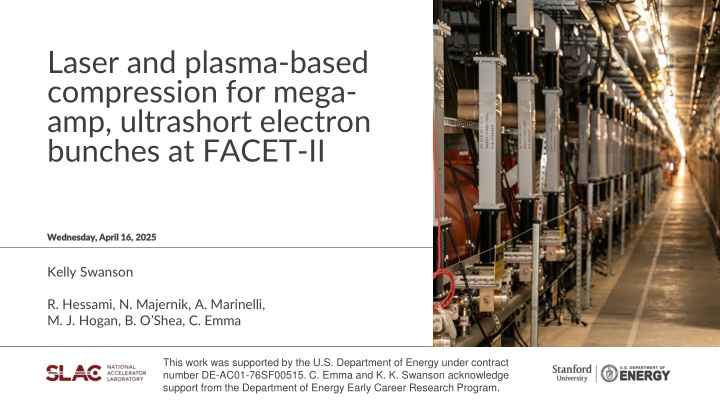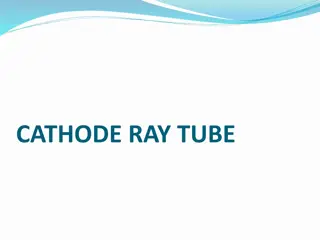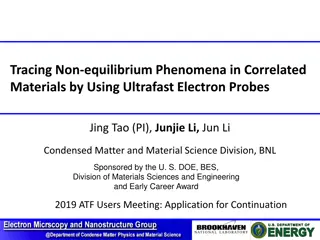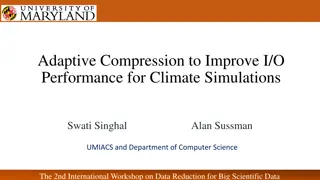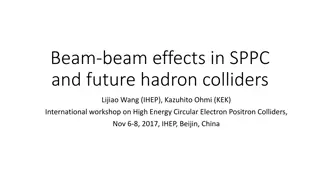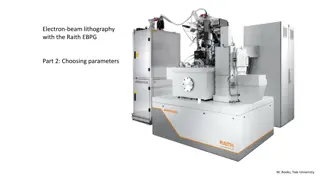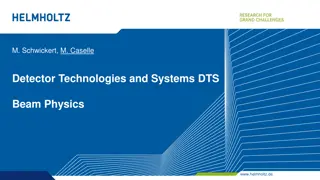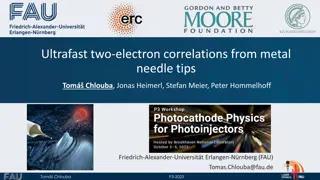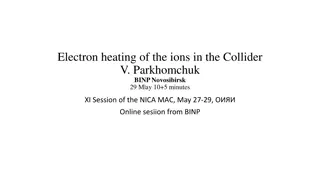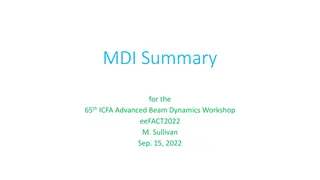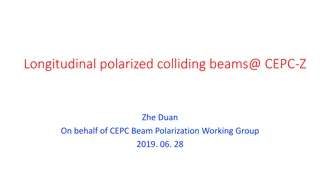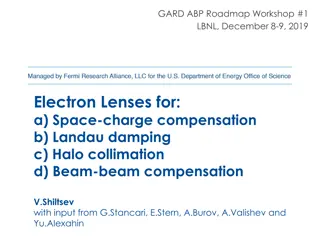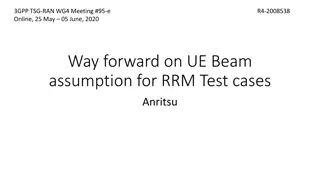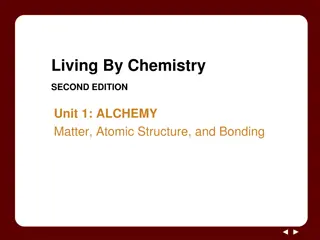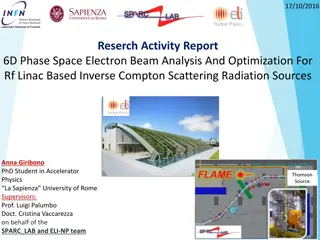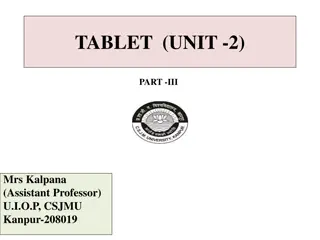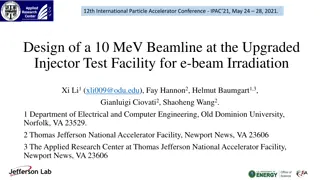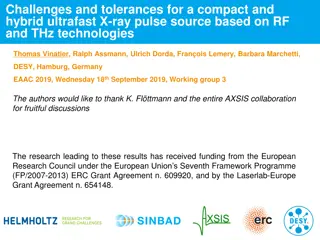Advanced Beam Compression Techniques for Ultrafast Electron Bunches
Advanced techniques utilizing laser and plasma-based compression for generating short, high-peak current electron bunches are crucial for various applications. This study at FACET-II explores innovative methods to compress beams to sub-micron scales with over 100 kA, addressing challenges in current state-of-the-art accelerator technologies. By manipulating longitudinal phase space and utilizing RF cavities and magnetic chicanes, researchers aim to unlock unprecedented opportunities in ultrafast quantum dynamics and advanced accelerators. The development of extreme beam compression methods is essential for attosecond light sources and laboratory astrophysics, offering new insights into particle beam generation and manipulation.
Download Presentation

Please find below an Image/Link to download the presentation.
The content on the website is provided AS IS for your information and personal use only. It may not be sold, licensed, or shared on other websites without obtaining consent from the author.If you encounter any issues during the download, it is possible that the publisher has removed the file from their server.
You are allowed to download the files provided on this website for personal or commercial use, subject to the condition that they are used lawfully. All files are the property of their respective owners.
The content on the website is provided AS IS for your information and personal use only. It may not be sold, licensed, or shared on other websites without obtaining consent from the author.
E N D
Presentation Transcript
Laser and plasma-based compression for mega- amp, ultrashort electron bunches at FACET-II Wednesday, April 16, 2025 Wednesday, April 16, 2025 Kelly Swanson R. Hessami, N. Majernik, A. Marinelli, M. J. Hogan, B. O Shea, C. Emma This work was supported by the U.S. Department of Energy under contract number DE-AC01-76SF00515. C. Emma and K. K. Swanson acknowledge support from the Department of Energy Early Career Research Program.
Extreme beams unlock unprecedented opportunities Attosecond light sources Emma et al., APL Photonics. 6, 076197 (2021) Laboratory Astrophysics New Collider Concepts Yakimenko et al., Phys. Rev. Lett. 122, 190404 (2019) Macchi, Pegoraro, Nature Photonics 12, 314 (2018) Benedetti, Tamburini, Keitel, Nature Photonics 12, 319 (2018) Ultrafast Quantum Dynamics TeV/m Advanced Accelerators Strong field QED Rosenzweig et al., NIMA 653 11 (2011) Matheron et al., Communications Physics 6 141 (2023) Cesar et al., Optica 10 1 (2023) Particle beams with ultrashort durations and high peak currents are of interest to many applications but remain a challenge to generate. 2 QED Quantum Electrodynamics
New techniques are needed to compress beams to <1 um with >100 kA Current state of the art FACET high field LCLS XLEAP LCLS nonlinear compression SIOM LWFA FEL LCLS dispersion UCXFEL DESY FLASH LCLS SASE LCLS short pulse 3
New techniques are needed to compress beams to <1 um with >100 kA Current state of the art FACET high field LCLS XLEAP LCLS nonlinear compression SIOM LWFA FEL LCLS dispersion UCXFEL DESY FLASH LCLS SASE LCLS short pulse 4
Short, high-peak current bunches can be generated by manipulating the beam s longitudinal phase space A (nearly) linear energy variation imprinted onto the bunch by an RF cavity combined with path length differences in a magnetic chicane result in compression. Magnetic chicane adds energy-dependent path length Energy modulator adds chirp h E E/E0 E/E0 E/E0 t t t E.g. Radiofrequency cavity Chicane parameters Chirp Initial bunch length Initial slice energy spread 5
Short, high-peak current bunches can be generated by manipulating the beam s longitudinal phase space A (nearly) linear energy variation imprinted onto the bunch by an RF cavity combined with path length differences in a magnetic chicane result in compression. Magnetic chicane adds energy-dependent path length Energy modulator adds chirp h E E/E0 E/E0 E/E0 t t t E.g. Radiofrequency cavity If h = -1/R56 6
Short, high-peak current bunches can be generated by manipulating the beam s longitudinal phase space A (nearly) linear energy variation imprinted onto the bunch by an RF cavity combined with path length differences in a magnetic chicane result in compression. Magnetic chicane adds energy-dependent path length Energy modulator adds chirp h E E/E0 E/E0 E/E0 t t t E.g. Radiofrequency cavity Effects of coherent synchrotron radiation Small chirps and collective effects during compression limit final duration 7 W. Lou, Y. Cai, C. Mayes, G. White Proc IPAC 2021 WEPAB234
Laser-based Beam Shaping Plasma-based Compression 8
Laser-based Beam Shaping Plasma-based Compression 9
The FACET-II accelerator can deliver high-intensity beams for a wide variety of experiments Parameter Value Energy (GeV) 10 Charge (nC) 2 Slice energy spread (% rms) 0.1 Spot size (um) 20 Duration (um) 10 10
Laser-based shaping generates tunable, short current spikes fs current spike Parameter Drive Energy (GeV) 10 Charge (nC) 2 Slice energy spread (% rms) 0.1 Spot size (um) 20 Duration (um) 10 11 Original work done on LH Shaping experiments/sims at LCLS/LCLS-II: Marinelli et al., PRL (2016), D. Cesar et al PRAB (2021), S. Li et al arXiv:2404.02299v1 (2024)
Suite of diagnostics characterize duration and current of spike fs current spike 12 Original work done on LH Shaping experiments/sims at LCLS/LCLS-II: Marinelli et al., PRL (2016), D. Cesar et al PRAB (2021), S. Li et al arXiv:2404.02299v1 (2024)
Suite of diagnostics characterize duration and current of spike SYAG + notch 13 Original work done on LH Shaping experiments/sims at LCLS/LCLS-II: Marinelli et al., PRL (2016), D. Cesar et al PRAB (2021), S. Li et al arXiv:2404.02299v1 (2024)
Suite of diagnostics characterize duration and current of spike UV-Visible spectrometer Coherent emission from N electrons 14 Original work done on LH Shaping experiments/sims at LCLS/LCLS-II: Marinelli et al., PRL (2016), D. Cesar et al PRAB (2021), S. Li et al arXiv:2404.02299v1 (2024)
Spectrometer used as diagnostic for locating the current spike Spike location with ~200pC Emma, et al., PRL (2025) Reduction in CSR emission reveals current spike is highly localized in energy and time
CSR spectra demonstrate change in bunch structure with laser heater Spectra with heater off show spikey structure in beam Spectra with heater on show smooth exponential decay consistent with a seeded fs-current spike x10-3 Emma, et al., PRL (2025) Reduction in CSR emission reveals current spike is highly localized in energy and time
Advanced shaping could enable custom current profiles Two bunches with variable spacing Multi-spike for resonant PWFA High laser energy Low laser energy At Laser Heater 200 um 150 um At Experiment 50 um
Laser heater beams delivered to user experiments Laser heater Current state of the art FACET high field LCLS XLEAP LCLS nonlinear compression SIOM LWFA FEL LCLS dispersion UCXFEL DESY FLASH LCLS SASE LCLS short pulse 18
Laser-based Beam Shaping Plasma-based Compression 19
Bunch compression with RF cavities is constrained by the achievable chirp Magnetic chicane adds energy-dependent path length Energy modulator adds chirp h E E/E0 E/E0 E/E0 t t t E.g. Radiofrequency cavity RF cavities can produce bunches with ~10s kA peak current and ~micron durations. However, producing shorter beams remains a challenge due to small chirps (%/mm). 20
Plasma wakefields can impart orders of magnitude larger chirps Magnetic chicane adds energy-dependent path length Energy modulator adds chirp h E E/E0 E/E0 E/E0 t t t Plasma wave Chirps x1000 larger possible in a plasma wakefield (%/um) compared with RF cavity (%/mm) 21
Start-to-end simulations explore the potential and limitations of plasma-based compression Focusing triplet FACET-II Bmad QPAD 2.5 %/um and 500 pC 0.3 %/um and 50 pC Parameter Drive Witness Energy (GeV) 10 10 Charge (nC) 1.3 0 - 0.6 Slice energy spread (% rms) 0.1 0.1 Spot size (um) 20 20 Duration (um) 10 10 22 Paper in progress
Longitudinal electric fields present in the wake induce large chirps 23
Longitudinal electric fields present in the wake induce large chirps Plasma density Driver spot size Driver current 24
Longitudinal electric fields present in the wake induce large chirps Plasma density Driver spot size Driver current 25
Longitudinal electric fields present in the wake induce large chirps Plasma density Driver spot siz e Driver current Before plasma After plasma Charge (pC) Charge (pC) Energy (GeV) Energy (GeV) 26
Witness charge requires balancing higher current with beamloading limits Witness charge limited by flattening of the accelerating field, reducing the final chirp Can compensate by increasing plasma length Lp 27
Plasma-based compression is adaptable to different configurations for broad applicability Gas jets Lithium oven Channels Beam driver Laser driver External injection Plasma injection 28
Bmad simulations provide insights into the propagation and compression of beams through the chicane Focusing triplet FACET-II FACET-II Charge (pC) Energy (GeV) Energy (GeV) Charge (pC) Beam propagation through magnetic chicane modeled in Bmad Allows for consideration of transverse and collective effects that can increase bunch duration 29
Larger chirps lead to more compressed bunches with diminishing returns Final bunch length + higher order terms Before plasma 2.5 %/um Energy (GeV) Chirps O(1 %/um) required to reach 0.1 um compressed bunches. 30
1 MA bunches possible with plasma-based compression Plasma-based compression Laser heater Current state of the art FACET high field LCLS XLEAP LCLS nonlinear compression SIOM LWFA FEL LCLS dispersion UCXFEL DESY FLASH LCLS SASE LCLS short pulse 31
Scaling laws and simulations help design experiments at FACET-II for strong field quantum electrodynamic studies Matheron et al., Communications Physics 6 141 (2023) Compressed witness Parameter Drive Witness 10 Energy (GeV) 10 10 As much as possible Charge (nC) 0 - 1.5 0 - 1 Slice energy spread (% rms) -- 0.1 0.1 20 Spot size (um) 20 20 Chirp = 0.1%/um 1 Duration (um) 10 10 1016 - 1017cm-3 60 cm Li oven 1.5 nC 400 pC Plasma density Witness charge Energy (GeV) D+W bunches Plasma target Mitigate detrimental transverse dynamics Generate a strong enough plasma wake Balance required chirp and maximize charge Constrained by accelerator capabilities 32
Initial plasma experiments study induced chirp and beamloading Notch in electron beam creates two bunches with tunable separation Plasma target was a 60 cm-long Lithium oven with plateau density 5x1016cm-3 Transverse deflecting cavity Energy spectrometer
Simulations highlight compression and potential improvements Transverse deflecting cavity Before the plasma After the plasma After the chicane Drive Witness 1 %/um chirp Even with beamloading, can still compress the bunch by a factor of x14 Future experiments will reduce the witness charge to mitigate beamloading Beamloading 0.2 %/um chirp 0.7 um rms
Simulations highlight compression and potential improvements Transverse deflecting cavity Before the plasma After the plasma After the chicane Drive Witness Even with beamloading, can still compress the bunch by a factor of x14 Future experiments will reduce the witness charge to mitigate beamloading
Next generation of extreme beams are made possible by plasma- based compression and laser-based beam shaping Plasma acceleration experiments at FACET-II rely on the 0.1 MA current spikes generated using the laser heater for improved performance and stability Experiments underway are benchmarking simulations for plasma- based compression Chicane and vacuum chamber to be installed for experiments utilizing extreme beams SF QED Attosecond x- rays Quantum probe kswan@slac.stanford.edu 36
Ongoing investigations are focused on understanding the wakefield structure by varying bunch separation PRELIMIARY RESULTS FROM E300 EXPERIMENT
New opportunities enabled by ultrashort particle bunches Nonperturbative QED collider Novel accelerating schemes Strong field QED Better understanding of quantum electrodynamics under intense electromagnetic fields 100 GeV-class collider to study nonperturbative QED Bunch duration ~ 0.05 nm A. Matheron, et al., Commun. Phys. (2023) Bunch duration ~ 10-100 nm Bunch duration ~ 10-100 nm M. F. Gilljohann, et al., JINST (2023) V. Yakimenko, et al., PRL (2019) Particle beams with ultrashort durations and high peak currents are of interest to many applications but remain a challenge to generate. QED Quantum Electrodynamics 39
Achievable bunch length and peak current constrained by collective effects and transport dynamics Available targets Linac limitations Drift slippage Betatron slippage Chromatic aberrations Velocity debunching Emittance debunching Betatron radiation Injection mechanism Beam loading Injection mechanism Space charge Peak current limitations Coherent synchrotron radiation 40
Coherent synchrotron an ultimate limit on compression but negligible for current parameters of interest Tradeoff between compression and emittance growth Partially mitigated by chicane design (larger chirps enable smaller bend radii) 41
Plasma-based bunch compression opens opportunities to study new physics Novel accelerating schemes (crystals) NP-QED collider Strong- field QED Parameter FACET-II Near-term application of extreme beams: beam-foil collisions to probe strong-field QED Beam energy (GeV) 10 10 125 10 Charge (nC) 1.2 0.01 1.5 1 Duration (um) 1 0.1 0.1 0.05 Peak current (kA) 300 50 1700 6000 Spot size (um) 3 0.01-0.1 0.01 10 A. Matheron, et al., PRL (2021) Density (cm-3) 1022 1023 1027 1020 Achievable Within reach Requires further study QED = Quantum Electrodynamics, NP-QED = non-perturbative QED, 42
